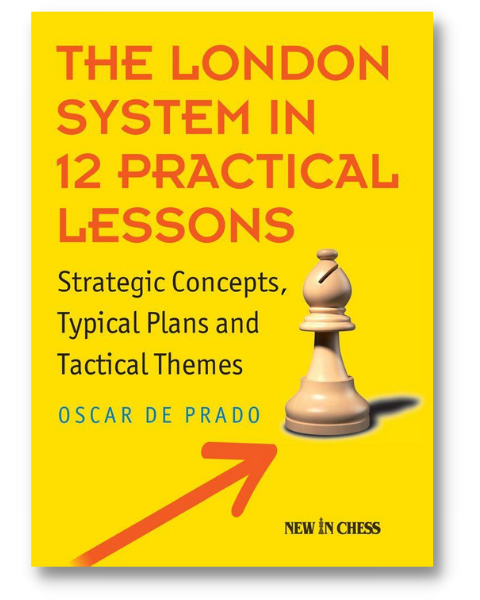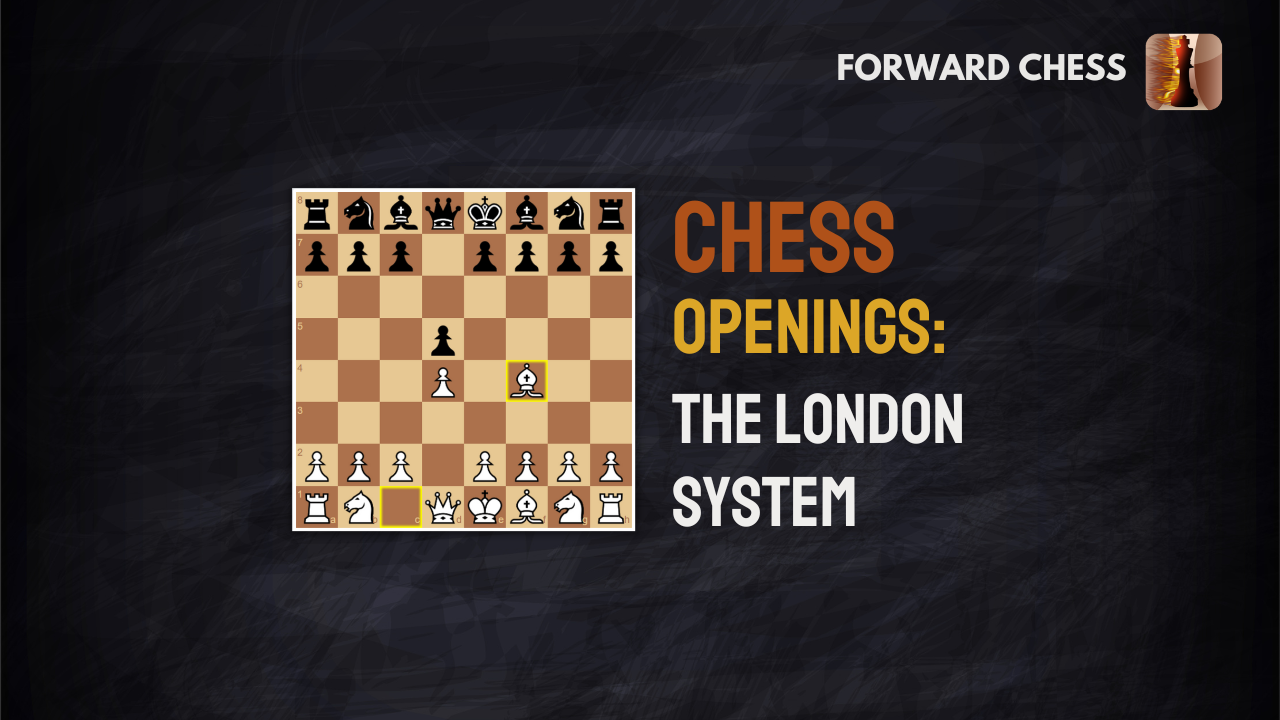Every now and then something comes along that becomes all the rave for a period of time. In recent years we have seen this quite often – from NFTs to airfryers. In the chess world, this “something” has been the London System. Chances are you have heard of this opening – either from players who comfortably employ it themselves or by players who absolutely despise playing against it. Either way, in this post you will learn more about what the London System entails – its origins, theory, and how to learn it.
Opening a game of chess with 1.d4 offers a vast array of possibilities and the London System is one of the most straightforward yet effective systems for White. Characterized by early pawn advances to d4 and e3, followed by the development of the dark-squared bishop to f4, the London System is all about simple development and flexible plans. Note that White can also opt for Nf3 before Bf4, but the latter has become more prominent in recent years and will be our main focus.
The London System: Table of Contents
- London System Background
- London System Theory
- The …Nf6 and …e6 setup
- The …g6 setups
- 1.d4 Nf6 2.Bf4 g6 3.e3
- 1.d4 Nf6 2.Bf4 g6 3.Nc3
- The …c5 setups
- 1.d4 d5 2.Bf4 c5
- 1.d4 Nf6 2.Bf4 c5
- Learn to play the London System
London System Background
The London System has been around for over a century but has seen an increase in popularity in recent years due to its inherent simplicity and the ability to sidestep a lot of mainstream opening theory.
Name Origins
Curiously, there isn’t a definite historic event tied to the naming of the London System. The name likely stems from its early adoption by British players and usage in various London-based tournaments.

In chess, a “system” refers to an opening where the player can follow a consistent set of plans or move orders, often independent of the specific moves of the opponent. The idea is to achieve a familiar pawn structure or piece setup, allowing the player to understand and execute typical plans, maneuvers, and ideas with confidence. Systems are generally solid, and make learning theory easier through reduced memorization.
History
This opening started to gain some attention in the early 20th century, and has been employed by World Champions like Tigran Petrosian and Anatoly Karpov. Its resurgence in recent years can be attributed to top players seeking less-explored paths and steering the game into middle-game positions they are comfortable with. Similarly, the opening has become extremely popular amongst novice and club players due to its easy setup with minimal theory to learn.
London System Theory
White’s setup involves d4, Nf3, Bf4, e3, h3 (sometimes), c3, Bd3, and Nbd2. The structure is solid and can be adopted against a variety of Black setups.
Black has a few different setups to choose from,
…Nf6 and …e6 Setups
1.d4 d5 2.Bf4 Nf6 3.e3 e6
White’s plans:
- White’s common moves here include Nf3, Bd3, c3, Nbd2, forming a robust setup.
- It is important for White to not allow Black to break with …e5. A common idea is to control the e5-square by playing Ne5 at some point.
Black’s plans:
- Black simply looks to develop pieces harmoniously and get a solid position.
- Black can opt for …Bd6 to challenge White’s Bf4, which is a typical idea in many openings against the London System. Black can fianchetto the light-squared bishop with …b6 and …Bb7.
- …c5 is often played, challenging White’s center before developing …Nc6. Note that White almost always defends d4 with c3.
A typical line:
…g6 setups
1.d4 Nf6 2.Bf4 g6
These setups often resemble King’s Indian or Grunfeld Defenses where Black allows White to occupy the center, with the intention to challenge it later. After 2…g6, White has two main ways to respond; 3.e3 and 3.Nc3.
3.e3
This keeps in line with the main London System setups where White will develop their pieces with the usual approach.
White’s plans:
- White develops their pieces with the usual London System approach (Nf3, c3, Nbd2)
- The light-squared bishop tends to develop to e2 instead of d3, since …g6 by Black closed the b1-h7 diagonal.
- An important move to include is h3, not to necessarily defend g4, but rather to open up the h2-square for the dark-squared bishop to retreat to if necessary.
Black’s plans:
- Black aims to complete the fianchetto setup and castle quickly.
- Black follows up with …d6, …Nbd7, and eventually …c5 or sometimes …e5 to attack White’s center
A typical line:
Of course this is one way for the game to continue, and there are many alternatives for both sides.
3.Nc3
This setup in the London System adds a wrinkle to the game that can be quite challenging for Black. With 3.Nc3, White is deviating from more traditional London System plans that often involve Nf3 and e3, aiming for a more aggressive approach. White plans to push e4 next, which Black must decide to allow by continuing with …Bg7, or to prevent by continuing with …d5.
3.Nc3 d5
Black can counter with …d5 to challenge White’s center immediately. After 4.e3 Bg7 White’s main move is 5.h4 which represents the type of solid attacks that White can get with a Kingside pawn storm, in many lines.
White’s threat is to go for h5 and open up Black’s Kingside, so Black usually opts for 5…h5 to prevent this. Play may continue with 6.Nf3 0-0 7.Ne5 and Black tries to break with 7…c5.
White can also omit h4 and instead go for a quieter 5.Nf3 which is followed by similar piece development as in the 5.h4 line. An important idea for both sides to be aware of though, is if Black “quietly” responds with the normal-looking 5…Nc6 which is in fact a blunder because of 6.Nb5!
3.Nc3 Bg7
The Bg7 setup often leads to a complex, strategic battle that can transpose into various other opening systems.
The immediate plan for White might involve playing e4 which creates a pawn duo in the center, aiming to gain space and set the stage for aggressive piece play. Some lines can involve the move Qd2, followed by long castling. This can lead to interesting attacking prospects, including ideas like Bh6 to exchange the dark-squared bishop and weaken Black’s kingside.
Potential Transpositions:
- Pirc or Modern Defense: If White pushes e4 and Black responds with …d6, we may get positions that closely resemble the Pirc or Modern Defense.
- King’s Indian Defense (KID): If Black chooses to play …d6 followed by …Nbd7 and e5, the position can resemble typical King’s Indian structures.
A typical line:
…c5 setups
Black’s move …c5 is a direct and active way to challenge White’s setup, aiming for quick counterplay and attempting to undermine the d4 pawn. There are a few main ways for Black to employ this – either with …d5 or …Nf6. Let’s take a look:
1.d4 d5 2.Bf4 c5
This is a direct approach, immediately challenging the d4 pawn. White can capture, but best is e3, supporting the d4-pawn. After 3…Nc6 4.c3 play can continue with 4…Nf6 but an important line to know is 4…Qb6:
Here White opts for either 5.Qc2 or 5.Qb3, but the following is a funky line:
5.Qb3 c4 6.Qc2 e5! 7.dxe5 Bf5
And White must play 8.Qc1 because the black bishop is poisonous and should not be captured with 8.Qxf5? Black’s f5 bishop was sent to lure the white queen away from the b2-pawn so that Black can capture 8…Qxb2 and pick up the white rook next.
1. d4 Nf6 2. Bf4 c5
Here, Black combines the Indian setups with the direct …c5 challenge. Once again, White defends with 3.e3 but now Black can immediately play 3…Qb6, targeting the b2-pawn. This is an important line for White to learn as the best move is the not-so-obvious 4.Nc3,, allowing Black to capture on b2.
The following is a typical continuation:
It’s worth noting that in the …c5 lines against the London System, understanding typical pawn structures, piece placement, and strategic goals is more crucial than memorizing specific move orders. While the London System itself is a “systematic” opening, the …c5 break by Black seeks to make the game more dynamic and less about routine development.
There are of course a few different setups for both sides, and we have by no means covered them all. Theory is still developing and there are many lines to choose from to suit your taste!
Learn to Play the London System
Books to Learn From

The London System: The Adventure Continues
Publisher: Chess Fortress
Author: Nikola Sedlak
Level: Intermediate

Trompowsky Attack and London System
Publisher: New in Chess
Author: Viktor Moskalenko
Level: Intermediate

The London System in 12 Practical Lessons
Publisher: New in Chess
Author: Oscar de Prado
Level: Intermediate

First Steps: The Colle and London Systems
Publisher: Everyman Chess
Author: Cyrus Lakdawala
Level: Beginner
Game Examples
Carlsen – Maghsoodloo
London System: …g6 setups
Kamsky – Goganov
London System: …Nf6 and …e6 Setups
Liren – Nepomniachtchi
Even though this London started with 2.Nf3, I feel it is important to include game 6 from the Ding – Nepo World Championship match. The fact that this opening appeared in the highest level of chess (and White won!) proves that it not just a simple club-level choice.
And that’s all folks!
Have any questions, or opening suggestions? Let us know in the comments!
- The Power of Pattern Recognition: The Woodpecker Method 2 - August 20, 2024
- Rock Solid Chess: Volume 2 - February 21, 2024
- Unsung Heroes of Chess - February 19, 2024

This summary by Charlize is so good and lucid that I decided not to buy books on London system 🙂